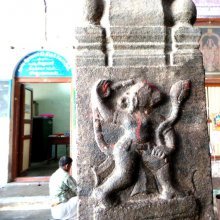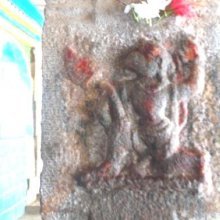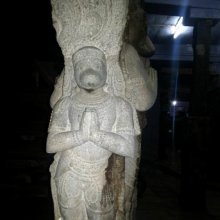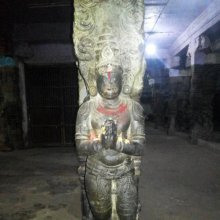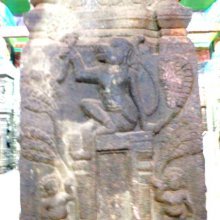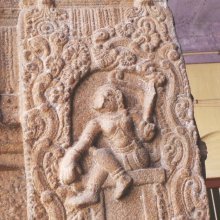Anjaneya, Āñjaneya, Amjaneya: 9 definitions
Introduction:
Anjaneya means something in Hinduism, Sanskrit. If you want to know the exact meaning, history, etymology or English translation of this term then check out the descriptions on this page. Add your comment or reference to a book if you want to contribute to this summary article.
Images (photo gallery)
(+16 more images available)
In Hinduism
Shilpashastra (iconography)
Source: Shodhganga: The significance of the mūla-beras (śilpa)Āñjaneya is the name of a deity depicted at the Ranganathaswamy Temple in Srirangam (Śrī Raṅgam), which represents a sacred place for the worship of Viṣṇu.—The devotee enters the temple from one of the entrances where there is the sannidhi for Āñjaneya. Āñjaneya is found in samapāda-sthānaka with hands in añjali-hasta. To the left of the sannidhi of Āñjaneya is the sanctum for Rāmānuja. To the right, there are the sanctums for Garuḍ āl vār, Cakratālvār, Viṣṇu Durgā and Veṇugopāl. As one proceeds further from the Āñjaneya’s sannidhi, there is the Garuḍa Maṇḍapa where Garuḍ a is found in añjali-hasta.
Āñjaneya is also depicted at the Andal Temple in Srivilliputtur (Villiputtur or Thiruvilliputtur), representing a sacred place for the worship of The Goddess (Devī).—To the left of the main entrance, there is the sannidhi for Śrī Āñjaneya (Hanumān). He is found standing in samapāda-sthānaka and samabhaṅga with the hands in añjali-hasta. As the devotee preceeds to the outer passage from the sannidhi of Śrī Āñjaneya, he/she finds the sannidhi of Śrīnivāsa Sundarāja.

Shilpashastra (शिल्पशास्त्र, śilpaśāstra) represents the ancient Indian science (shastra) of creative arts (shilpa) such as sculpture, iconography and painting. Closely related to Vastushastra (architecture), they often share the same literature.
Languages of India and abroad
Sanskrit dictionary
Source: DDSA: The practical Sanskrit-English dictionaryĀñjaneya (आञ्जनेय).—[añjanāyāḥ apatyaṃ ḍhak] Name of Māruti.
Derivable forms: āñjaneyaḥ (आञ्जनेयः).
Source: Cologne Digital Sanskrit Dictionaries: Shabda-Sagara Sanskrit-English DictionaryĀñjaneya (आञ्जनेय).—m.
(-yaḥ) A name of the monkey Hanuman. E. añjanā the mother of Hanuman, and ḍhak patronymic affix which leaves eya.
Source: Cologne Digital Sanskrit Dictionaries: Aufrecht Catalogus Catalogorum1) Āñjaneya (आञ्जनेय) as mentioned in Aufrecht’s Catalogus Catalogorum:—Quoted in Saṃgītadarpaṇa. Oxf. 201^a.
2) Āñjaneya (आञ्जनेय):—Bhagavadgītābhāṣya. Oppert. Ii, 7900.
Source: Cologne Digital Sanskrit Dictionaries: Monier-Williams Sanskrit-English Dictionary1) Āñjaneya (आञ्जनेय):—m. ‘son of Añjanā’, Name of the monkey Hanumat, [Mahāvīra-caritra]
2) Name of an author
Source: Cologne Digital Sanskrit Dictionaries: Yates Sanskrit-English DictionaryĀñjaneya (आञ्जनेय):—[ā-ñjaneya] (yaḥ) 1. m. Hanumān.
[Sanskrit to German]
Sanskrit, also spelled संस्कृतम् (saṃskṛtam), is an ancient language of India commonly seen as the grandmother of the Indo-European language family (even English!). Closely allied with Prakrit and Pali, Sanskrit is more exhaustive in both grammar and terms and has the most extensive collection of literature in the world, greatly surpassing its sister-languages Greek and Latin.
Kannada-English dictionary
Source: Alar: Kannada-English corpusĀṃjanēya (ಆಂಜನೇಯ):—[noun] one of the famous gods, the son of Anjane and the Wind-God,with the face and tail of a monkey, a devout servant of Śrī Rāmacandra, in Rāmāyaṇa.
Kannada is a Dravidian language (as opposed to the Indo-European language family) mainly spoken in the southwestern region of India.
See also (Relevant definitions)
Partial matches: A.
Starts with: Ancaneyan, Anjaneyamanu, Anjaneyapurana, Anjaneyastava, Anjaneyastotra.
Full-text: Anjanika, Anjaneyapurana, Anjaneyastava, Anjaneyastotra, Mukhyaprana, Hanuma, Elaranuga, Vyamsita, Hanuva, Anilaja, Sankalapura, Somnath, Anila, Bhagavad-gita.
Relevant text
Search found 12 books and stories containing Anjaneya, Āñjaneya, Āṃjanēya, Ā-ñjaneya, A-njaneya, Amjaneya, Āñjanēya, Āṃjaneya; (plurals include: Anjaneyas, Āñjaneyas, Āṃjanēyas, ñjaneyas, njaneyas, Amjaneyas, Āñjanēyas, Āṃjaneyas). You can also click to the full overview containing English textual excerpts. Below are direct links for the most relevant articles:
Hanuman Nataka (critical study) (by Nurima Yeasmin)
Hanuman-Nāṭaka, Act 6 (Summary) < [Chapter 3]
9.17. The character of Hanumān < [Chapter 4]
Temples of Munnur (Historical Study) (by R. Muthuraman)
A Good Samaritan < [January – March, 1979]
Sparkles of Sundarakanda < [January – March and April – June, 1995]
Reminiscent of Mantralaya of Old < [October – December, 2007]
Animal Kingdom (Tiryak) in Epics (by Saranya P.S)
Sivaprakasam (Study in Bondage and Liberation) (by N. Veerappan)
Earlier Research Works < [Chapter 1 - Introduction]
The history of Andhra country (1000 AD - 1500 AD) (by Yashoda Devi)
Introduction (Kondapadumati Dynasty) < [Chapter IV - The Kondapadumatis (A.D. 1100-1282)]
Related products
